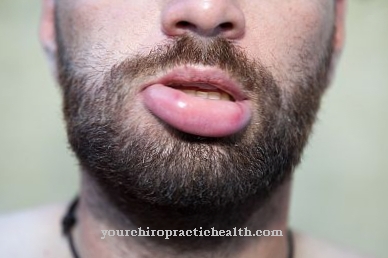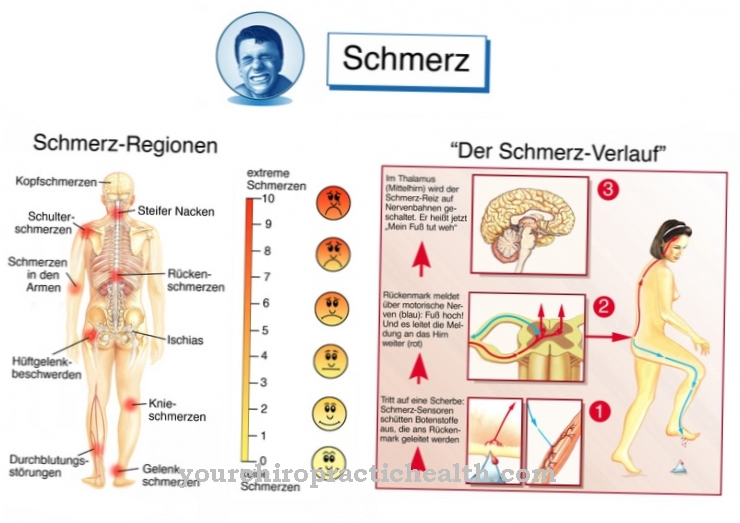A Photophobia or Photophobia indicates an increased sensitivity of the eyes to light. Other synonyms for it are: Hypersensitivity to light, and Light sensitive eyes. This is usually daylight, but artificial lighting can also be perceived as annoying. Therefore, the affected people often go to dark rooms to avoid the light stimulus.
What is photophobia?

In summary, all human diseases that arise from exposure to natural or artificial light are referred to as light sensitivity. The symptoms are varied.
In the neurological sense, light sensitivity is synonymous with so-called photosensitivity, the increased readiness of the brain to react to light influences, which leads to the discharge of nerve cells and even epileptic seizures.
In some cases, the photosensitivity also occurs due to medicinal factors, or it is a question of photodermatitis, in which the skin in particular is sensitive to light.
causes
Photophobia generally occurs in neurological diseases. But other diseases, such as migraines, meningitis (meningitis) and eye infections (conjunctivitis, iridocyclitis), can also be the cause of photophobia.
Other possible causes can be: cataracts, inflammation of the optic nerves, corneal inflammation, corneal scars after corneal infections, scratches in or on the eye, injuries to the surface of the eye and dry eyes.
If the light also leads to pain (light pain), there may be inflammation of the iris (iris skin). A quick consultation with an ophthalmologist is necessary.
Photophobia occurs less often in small children and infants, as this can then occur in the context of congenital glaucoma. Most albinos are also very sensitive to light.
There is no general cause of light sensitivity. However, if you look at the exact symptoms, you can draw conclusions and at least identify one possible complex of causes. People often speak of photosensitivity in connection with eyesight.
This means discomfort and pain caused by too bright light or headaches that result from it. Such symptoms appear accompanying others, for example in meningitis. In rare cases, they can also be a sign of a brain tumor.
Mostly, however, it is caused by a cold that also affects the eyes and makes them particularly sensitive to artificial light. Neural disorders that make people sensitive to light can also affect the eyes, but are mainly expressed as headaches or epileptic seizures due to exposure to light.
If light changes on the skin, there are other causes. St. John's wort preparations for depression are among the drugs that react to sun exposure on the skin and cause discomfort. However, underlying diseases are also possible, such as the autoimmune lupus disease.
You can find your medication here
➔ Medicines against photosensitivity and irritated eyesDiseases with this symptom
- Meningitis
- migraine
- cold
- Iritis
- Uveitis
- Aniridia
- Conjunctivitis
- Cataract
- epilepsy
- Eye flu
- Cluster headache
- measles
- glaucoma
- Brain tumor
- Systemic lupus erythematosus
- sunburn
- rabies
- tuberculosis
Complications
Photophobia is usually a symptom of an underlying medical condition. There are many causes. However, the sensitivity of the eyes to light can sometimes be associated with complicated disease processes. These complications usually do not occur as a result of photosensitivity, but rather accompany it.
Underlying diseases include neurological disorders, conjunctivitis, other eye infections, glaucoma or hereditary diseases such as albinism. If left untreated, glaucoma can lead to blindness. Even with its treatment, the preservation of the eyesight is not always guaranteed.
Photophobia in babies is very often an indication of congenital glaucoma. With eye and conjunctivitis, the increased exposure to light can lead to severe pain. Therefore, sensitivity to light proves to be a protective reaction of the body. Photophobia can also occur in connection with severe headaches such as migraines. In this case, too, the patient avoids light sources because they would only intensify the symptoms.
In albinism, the eyes are damaged by exposure to light, because the protective melanin, which absorbs the harmful UV radiation, is missing here. Therefore, albinos must always wear sunglasses to avoid going blind. In addition, sensitivity to light often provides the doctor with an indication of the presence of other serious illnesses that are themselves considered complications. Sensitivity to light can occur as a symptom of brain tumors or meningitis (meningitis).
When should you go to the doctor?
If photophobia occurs due to medication taken, it usually disappears after they are discontinued. The photophobia is usually noted on the package insert as a normal consequence of a prescribed preparation. A doctor's visit is only necessary if the sensitivity to light becomes dramatic or does not decrease after discontinuing the preparation.
Photophilia or photophobia can have different causes. Acute eye diseases or an acute migraine attack could be behind it. Infections or rare photosensitivity after penicillin treatment are also possible causes. A deficiency in vitamin B can - among other symptoms - be a reason for photophobia. A visit to the doctor should always take place if the person concerned is not clear about the causes of the sensitivity to light.
Particular attention should be paid to possible accompanying symptoms. This makes it easier for the person affected to consult the correct doctor. If you have problems with your eyesight, burning eyes or a foreign body sensation in combination with photophobia, the ophthalmologist is the right contact. In case of doubt, the family doctor is the best address. After the initial consultation and an examination, he can arrange for a referral to a specialist if necessary. This is necessary because a sudden photophobia can also hide meningitis or a concussion. Both need immediate treatment, especially in children.
Doctors & therapists in your area
Treatment & Therapy
Photosensitivity is rarely self-treated. It does not occur alone, but is always an accompanying symptom of a deeper cause. Therefore, treatment is to identify them and either inhibit or eliminate them.
Neuronal disorders such as epilepsy are suppressed with drugs. As a result, the photosensitivity largely disappears - the patient should still not expose himself to flickering light. If it is only a headache, the headache is treated symptomatically and the patient is advised not to provoke the brain with exposure to light, which is known to be dangerous.
If, on the other hand, it is a question of another disease, for example meningitis, this is primarily treated and not the photosensitivity itself. By healing the cause, the sensitivity to the light also disappears.
It becomes more difficult with autoimmune diseases. In such cases, the photosensitive skin reactions can be treated so that they regress.
If the eyes are dry, you can try to calm the surface of the eye with moist eye drops. Of course, sunglasses help against light sensitivity. If you are only slightly photophobic, glasses that can turn dark in sunlight are sufficient (photochromic glasses).
However, if the sensitivity to light also causes pain (light pain), a visit to an ophthalmologist is recommended as soon as possible to rule out iris inflammation. If, in addition to light sensitivity, there is also reduced visual acuity, an ophthalmologist should also be consulted.
Outlook & forecast
In most cases, the photophobia is caused by congenital glaucoma. This can lead to headaches and dizziness. Not infrequently, photophobia is also associated with inflammation of the eyes or conjunctiva. The affected person avoids all possible sources of light in order to protect himself from the pain. This severely restricts the affected person's everyday life. Social activities are also no longer easily possible and the patient often withdraws. In addition to pain, this can also lead to depression and other psychological difficulties, which can, however, be treated by a psychologist.
Treatment for photophobia always depends on the cause of the disease. If photophobia occurs after an epileptic seizure, medication treatment can alleviate the symptom. Meningitis can also be treated relatively well by taking medication, so that there are no further symptoms.
Patients can temporarily relieve photophobia by using sunglasses. However, this is not a long-term solution. If the photophobia also results in reduced visual acuity, it is necessary for the patient to wear a visual aid.
You can find your medication here
➔ Medicines against photosensitivity and irritated eyesprevention
The best way to prevent photosensitivity is to be careful not to get the infections that they cause. For example, meningitis is passed on through sharing a water bottle - this should be avoided. In the case of a cold, it can already help to avoid stress and to recover sufficiently - because stress often triggers sensitivity.
If there is an underlying condition that triggers photosensitivity, harmful types of light should be avoided whenever possible. This will prevent the symptoms from developing. If it turns out that the photosensitivity is related to certain medications, one should consult with the attending physician and choose another preparation.
You can do that yourself
Light-shy people can counteract the symptoms with the help of various measures. First of all, if you are sensitive to light, it is advisable to darken the rooms and use sunglasses to protect your eyes from excessive light. In order to relieve the eyes, attention should also be paid to a pleasant room climate and stress should be avoided if possible. A long nap often helps against acute light sensitivity.
In the long term, it helps to gradually get the eyes used to the light and to work out strategies together with the doctor to overcome the fear of light. Artificial tear fluid can also be used to relieve the eyes. Dietary measures and a generally healthy lifestyle with sufficient exercise and sufficient relaxation and rest also contribute to less sensitive eyes.
Preventive measures can be taken against sensitivity to light by avoiding infections and other physical ailments. With flu or a cold, the eyes are usually even more sensitive than usual and should be protected with a hat or sunglasses. In any case, strong photosensitivity should first be discussed with your family doctor, as there may be a serious underlying condition.



.jpg)




















.jpg)



